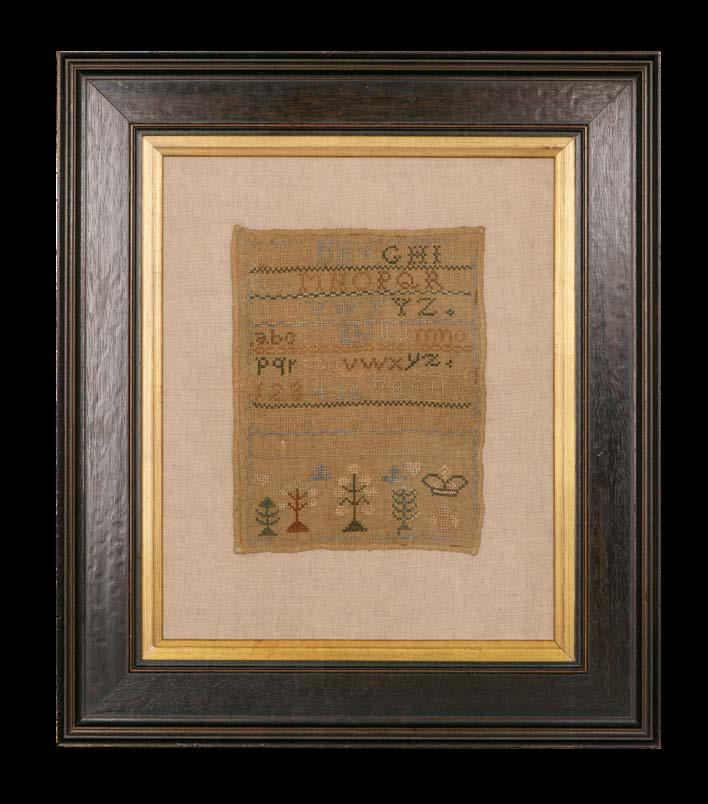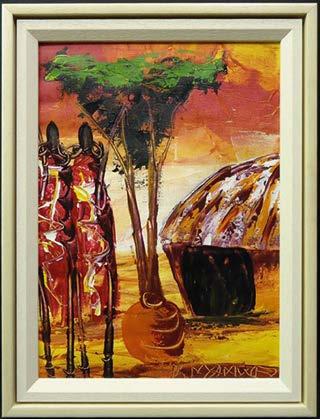
9 minute read
Attach quilters’ cotton wadding which will provide
colour runs, fraying and holes which may be present in older items. Also examine the fabric for rust marks which are evidence of it having been tacked onto a backing board. At this stage, consider if the customer needs to involve a textile conservator. Old textiles can often be dirty or creased. Do not attempt to clean or iron the item; this should be the responsibility of the customer. Remember there is very little that one can do to improve the aged appearance of antique fabric art. Samplers and other forms of embroidery often have loose threads or travelling stitches on the reverse. These may be removed to improve appearance but as a general rule NEVER take scissors to a customer’s work – that is their responsibility. Many textiles incorporate surface embellishments such as beads and ribbons. It’s important to check these are secure and to choose a moulding with sufficient rebate depth to house the finished article. Handle antique samplers as little as possible and with cotton gloves. Use conservation framing materials and techniques to preserve the item and to minimise further deterioration and fading.
12 Place a weight to hold the laced material in position while tying off the other end of the thread. and bottom edges, ensuring neat, square corners. edges and remove all pins.
Advertisement
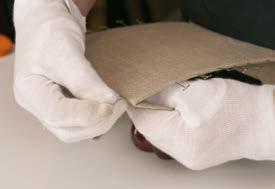
15 Carefully pin the sampler onto the donor material and secure it using stainless steel pins. choosing a good colour match with the sampler. Use a maximum of two strands. backstitch with gaps.
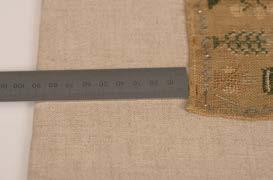
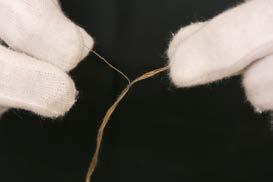
19 Use frame sealing tape or cotton museum tape to avoid any acids leaching from the wooden frame/slips and attacking the material. Use slips to hold the sampler away from the glass. (See above) Simply place them in the assembled frame without fixing. Use 3mm Plastazote ® for additional protection.
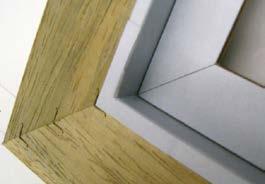

22 Create a reactive interface barrier system using RIBS foil, which will change colour when it needs to be replaced. Attach to the mountboard and
13 Remove side pins and replace them in the top
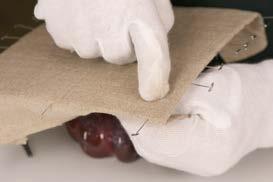
16 Use a single strand from multi-strand thread,
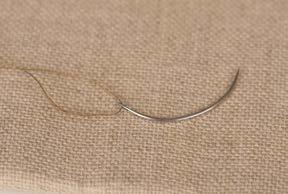
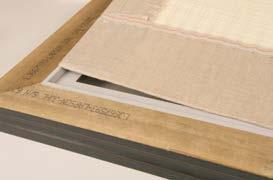
20 Place the mounted sampler in the frame.
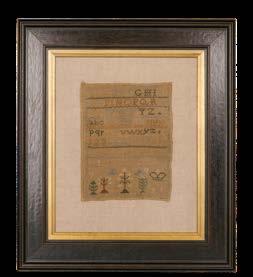
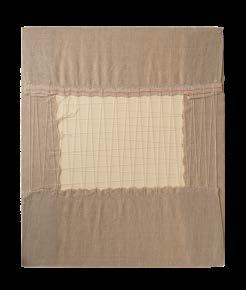
17 Thread a fine curved needle…
14 Repeat the lacing process along the remaining

18 …then stitch the sampler onto the linen using
21
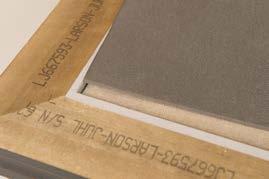
place in frame. 23 The finished job.
Materials used:
Moulding: LJ667593 Slip:161900246 Glass: Tru Vue ® Conservation ClearBDTVCC2501 Moutboard: BDTHMD3301 Evacon-R ™ SUEVAR0001 Plastazote ® BDPLAG0003 Cotton rag gummed paper 999000031 RIBS Foil SURIBS1219
Masterclass:
next issue
Three-dimensional objects come in all shapes and sizes. Customers present framers with a wide array of artefacts to be framed and displayed, ranging from champagne corks commemorating a special event to sports memorabilia, and from baby’s first shoes to a collection of model cars.
Each item requires a unique framing solution to ensure it remains undamaged and is firmly secured without the fixings being visible. Creative mounting can also be employed to showcase the artefact. Use of the correct framing materials is also important to achieve a quality finish. For example, using reflection-free art glass will allow the viewer to get ‘up close and personal’ to enjoy the framed object to the full.
In issue 12, Mal will take you step by step through the process of framing a Clarice Cliff style ceramic bowl. In addition to offering his handy tips to ensure a perfect box frame, he’ll demonstrate some clever finishing touches to inspire you to upsell and wow your customers with a creative framing solution to display their own artefacts.
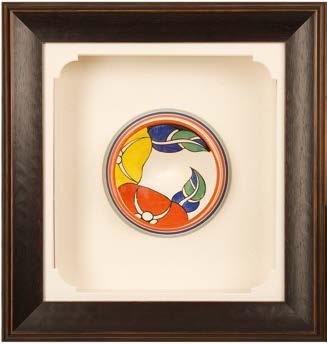
business profile A Sporting Chance
Business can be about taking risks, making contacts and bold investment decisions. You still need to speculate to accumulate, advises Adam Gascoigne of Sportsframe Ltd, but sometimes simply making the right decision at the right time can shape a business for the better. And, for an enthusiastic business owner, learning that Rome wasn’t built in a day can be tough.
Adam Gascoigne is a lucky man - his passion is also his job. He runs Sportsframe Ltd in Northamptonshire, collecting and framing sports memorabilia. The business has been running for 11 years and plans are now underway to grow the business.
Adam said: “I started framing as a hobby in 1998. I am sports mad – I especially love cricket. I started to pick up a few pieces of memorabilia and wanted to get them framed. I was amazed by the cost of framing. But moreover, I just couldn’t get people to grasp what I wanted or how I envisaged my piece on display.
“So, I thought I’d have a go myself. I did graphic design at university so I understand layout and design. I started to do these little projects in my garage. As I showed my mates how things turned out, they started bringing their things for me to frame or display. I also have friends in the sports industry and they would recommend me to other people. So I had two or three years of practising in my garage without the pressure of trying to make a living out of it. This coincided with the massive growth of ebay, so I was able to sell a few items online and see what the market was like.”
In 2002 Adam decided to take the plunge and go full time with his business. Soon after, he realised he needed premises too.
He said: “The original idea was to run it as an online business from home, but it soon became apparent we needed a workshop and extra storage space, as well as the basic need to separate work from home life. “We found a traditional framing business for sale in Wellingborough. Buying an established business was great because it had a good reputation and was already a destination for local people who wanted something framed. We were able to take on the traditional framing part of the business and also add our core business of sports memorabilia to the offering.
“My wife Laura had taken redundancy from work and she said she would spend a couple of months helping out while she looked for a job. It worked so well that she never left the business and we still run it together.
“We first planned to expand in 2008. We were going well, but the bottom just dropped out of everything that year and our business stalled. That was difficult enough, but then Laura became very ill. It was hard and frustrating. That is when we found running your own business can be a very lonely place.”
Thankfully Laura has made a good recovery and the couple are now in a position to begin expansion again.
Adam said, “Our business is progressing again and we’ve just opened a showroom in Highgate in London. It made sense to invest in this showroom as a good proportion of our work is London-based. We run it on an appointment only basis and we’re only 60 miles away so it means it’s easy for us to use. We’re also looking for a couple more premises up here in Northamptonshire with workshops big enough to take on some larger projects.”
Having built a sterling reputation within the sports industry, the Gascoignes are now growing into other areas of the memorabilia market.
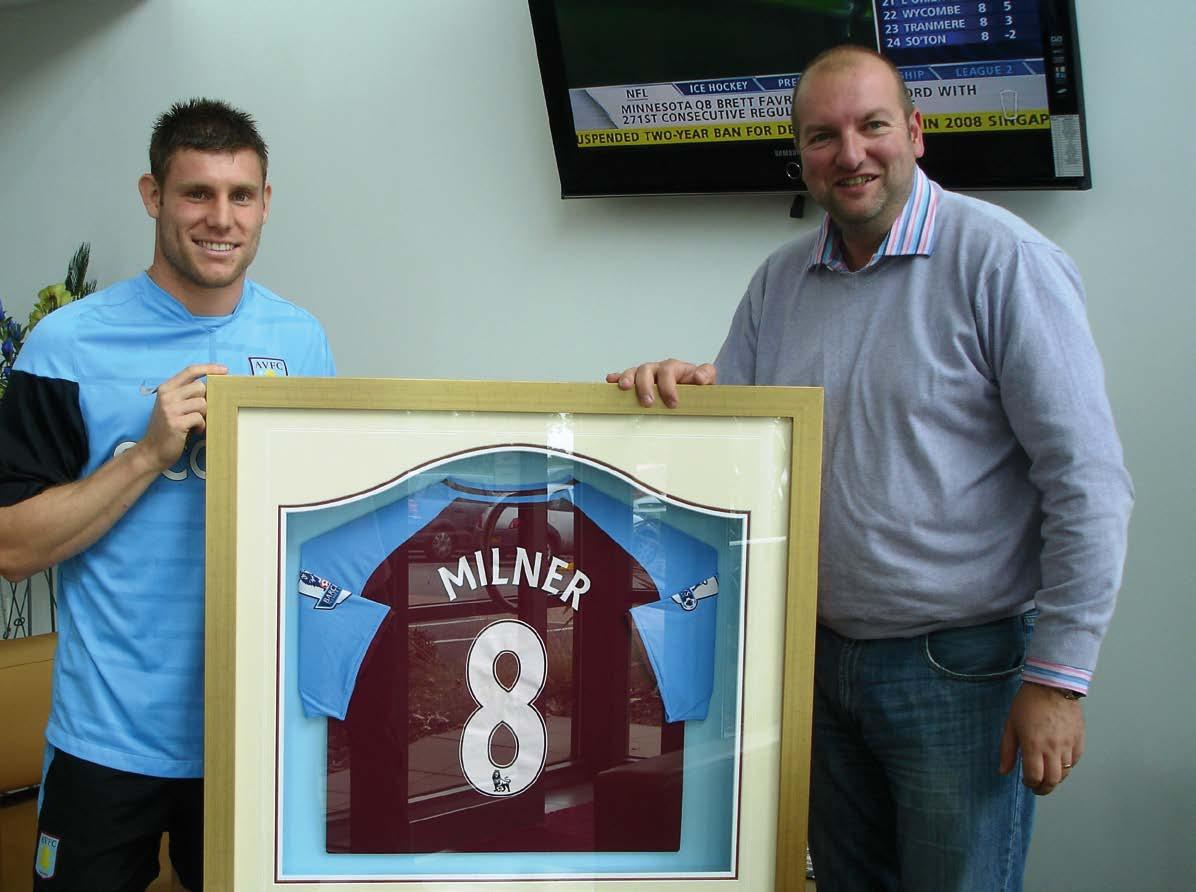
“We’re now looking at what other products and services we could bring to market. We have built up a lot of contacts in the sports industry from the elite teams like the national rugby and cricket sides. That puts us in a position where we are able to source unique items for private collectors, rather like the antiques trade.
“We’re also moving into more general memorabilia. We have an ongoing contract with the O2 Arena to install their backstage areas. Off the back of that, we’ve also secured a really exciting contract with Alexandra Palace, restoring and archiving their old black and white photos and scanning and reprinting them for display.
“We are also taking on joinery work to build bespoke, museum standard display cases in situ in clients’ homes and for this we’re using a lot of conservation products like the CXD range.”
Much of this new work has come to Sportsframe Ltd because of Adam’s continual investment in new technology.
“We’ve found it extremely important to keep ahead of the curve when it comes to investing in technology for the business. The biggest single springboard for our business was investing £25k in a mount cutter. It changed our business over night by freeing up our time to work on other things. About three years ago we also invested in large format print technology which has allowed us to take on a whole new range of contracts.
“We are also keeping an eye on the advent of the 3D printers. When the technology becomes more reliable and the cost comes down, I think we will invest. It will allow us to take a lot of services in-house which we currently outsource, therefore cutting our costs and speeding up our delivery times.”
With such growing business opportunity, amidst all his passion and enthusiasm there still lurk a few frustrations for Adam.
“Despite everything we’re doing, it is frustrating that the core business grows so slowly. There are mass market dealers like those who sell on ebay. But it’s a contrived memorabilia market - they get hold of replica shirts and get them signed by the job lot, put them in any old frame and sell them. There is a market for that kind of thing, but it’s not what we do. We can’t compete with those guys.
“Our market is bespoke, high-end and therefore, slower. We have fewer items; we buy one-offs; we never use the same design twice to display items; everything that comes from us is unique. That’s the way we see our business going.”
Adam’s business acumen:
• Consider buying an existing business as a going concern to get a head start on customer footfall.
• Invest wisely in technology which will help you secure new business
• Be patient and expand at a sensible rate – however frustrating • Know your business inside out and always look for the next client lead
• Have a ‘we can do that for you’ attitude. Look at aspects of your business which can be applied outside your core offering and expand your business. For more information visit www.sportsframe.co.uk

